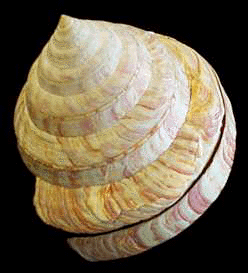|

Gastropod Main

Glossary

References

Links

Hooper Main |
Fossil Record 3
 |
Figure 16: A Pleurotomariina fossil from the Cambrian. One of the first successful gastropods, they acheived quite an abundance by 550 Ma, and still survive today as a "living fossil." |
The first gastropods were probably planispiral. As the oldest gastropod fossils like Helcionella testify, these planispiral bilaterally symmetrical species were members of the suborder Bellerophontacea. These were afforded much protection from their initial ability to withdraw completely into their shells, as evidenced by their abundance midway into the Cambrian. By the late Cambrian, the first helically spiralled, asymmetrical gastropods became abundant. The Pleurotomariina, still alive today, as living fossils are important indicators of the internal morphology and ecological habits of ancient gastropods. They have primitive gill structures, and reproduce simply by releasing eggs & sperm into the water to fertilize by chance.

|

|

|

|

|

